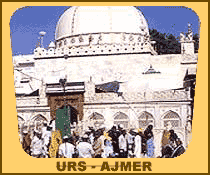| URS FAIR,
AJMER |
|
| Celebrated In
:
Ajmer, Rajasthan. |
|
| Feature :
Urs of Sufi Saint Khwaja -
Moin - Ud - Din Chisti |
|
| Time of the
festivity :
The First Six Days of Rajab |
|
|
|
| The lakeside city of Ajmer is
located in central Rajasthan, and is held in great reverence by devotees of all
communities who call it 'Ajmer Sharif' (Holy Ajmer). It is here that the mortal
remains of the highly respected Sufi saint Khwaja Moin-ud-din Chishti lie
buried. The Khwaja came from Persia and established the Chishtia order of
'fakirs' in India. He is popularly known as 'Gharib Nawaz' (protector of the
poor) because he dedicated his entire life to the service of mankind. His
spartan life spanned almost a hundred years and he embraced death in solitude
while he had withdrawn to his cell for six days, asking not to be disturbed. |
|
| The Dargah Sharif in Ajmer is the place where
the Saint's mortal remains lie buried and is the site of the largest Muslim
fair in India. More than five lakh devotees belonging to different communities
gather from all parts of the subcontinent to pay homage to the Khwaja on his
Urs (death anniversary) during the first six days of 'Rajab' (seventh month of
the Islamic calendar.) |
 |
|
|
| The pilgrims who come to seek the
blessings of the Khwaja make rich offerings called 'nazrana' at the holy spot
where the saint has been entombed. The offerings of rose and jasmine flowers,
sandalwood paste, perfumes and incense contribute to the fragrance that floats
in the air inside the shrine. Cash offerings are also made. Also offered by
devotees are the 'chadar', 'ghilaph' and 'neema', which are votive offerings
for the tomb. These are brought by devotees on their heads and handed over to
the 'khadims' inside the sanctum sanctorum. |
|
| Outside the sanctum sanctorum of
the Dargah, professional singers called 'qawwals' sit in groups and sing the
praises of the saint in a characteristic high pitched voice. People gather
around them and listen attentively, sometimes clapping to the rhythm of their
instruments. Cash is also offered in appreciation of noteworthy stanzas to the
qawwals. On the steps leading to the main gate, 'fakirs' can be seen begging
for alms in the name of the Khwaja. Their cries generally do not go in vain, as
the devotees feel happy to help the needy, in the tradition of Khwaja Gharib
Nawaj. |
|
| URS CEREMONIES |
| The Urs is initiated with the
hoisting of a white flag on the dargah by the Sajjada Nashin (successor
representative) of Chishtis. It is done on the 25th of Jamadi-ul-Akhir (sixth
lunar month), with the accompaniment of music. On the last day of the sixth
month, the 'Jannati-Darwaza' (gateway of heaven) is flung open early in the
morning. People cross this gate seven times with the belief that they will be
assured a place in heaven. On the 1st of Rajab, the tomb is washed with rose
water and sandalwood paste and anointed with perfumes. This ritual is called
'ghusal'. The tomb is then covered with an embroidered silk cloth by the
Sajjada Nashin. |
|
| At night, religious assemblies
called 'mehfils' are held in the 'mehfil khana', a large hall meant for this
purpose. These are presided over by the Sajjada Nashin of the dargah. |
|
| Qawwalis are sung and the hall is
packed to capacity. There are separate places reserved for women who attend the
'mehfil'. The 'mehfil' terminates late in the night with a 'fatiha', which is a
mass prayer for the eternal peace of the Khwaja in particular and mankind in
general. An interesting ritual is the looting of 'kheer' (milk- pudding), which
is cooked in two large cauldrons called 'degs' and distributed to the devotees
as 'tabarruk' (blessed food). |
|
| On the 6th of Rajab, after the
usual 'mehfil' and the sound of cracker-bursts accompanied by music; the
Sajjada Nashin performs the ghusal of the tomb. Fatiha and Salamti are read. A
poetic recitation called 'mushaira' is arranged in which poets of all
communities arrive to recite compositions dedicated to the Khwaja. The Qul
(end-all) on the 6th of Rajab marks the end of the Urs. |
|
| THE BAZAARS |
| The dargah is located at the
conjunction of three bazaars. There are a number of restaurants around the
dargah where visitors can choose from a variety of dishes most of which are
non-vegetarian preparations. Guest houses on the road leading to the Dargah
offer accommodation that ranges from economical to luxurious. Many other guest
houses are strewn across the city. The shops in the market around the Dargah
sell flowers, prayer mats, rosaries, textiles, and general merchandise as well. |
|
| Members of all communities have
access to the dargah. It is compulsory to remove the shoes, before entering, at
the main gate. Within the dargah premises, the head of the pilgrim should be
covered at all times. Many visitors engage the services of Mujavirs who take
their patrons around the dargah, fetch them 'tabarruk' and are duly rewarded. |
|
| OTHER ATTRACTIONS |
| Apart from the dargah, the
visitors go to see the Adhai din-ka Jhonpra (two-and-a-half-day hut) which is a
mosque noted for its ornate calligraphic inscriptions on the arches and walls. |
|
| People also climb up the hill of
Taragarh to pay homage at the shrine of Miran Sayyed Hussain, the first Muslim
Governor of the hill fort. |
|
|
|
|
|